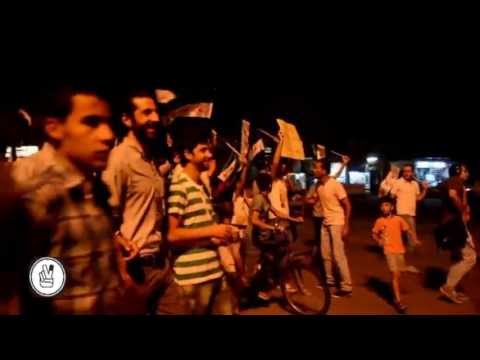LATEST: Video — Friday Protest in Aleppo for Islamic State of Iraq and as-Sham
SUMMARY: With much of northern Syria now long beyond the control of the Assad regime, local conflicts within a civil war are developing: insurgent factions are fighting with the Islamic State of Iraq and as-Sham for leadership within towns and the city of Raqqa.
Two events on Friday testified to this new aspect of the war. In Azaz, the town near Turkey occupied by ISIS on Wednesday after a deadly dispute with the Free Syrian Army;s Northern Storm Brigade, a cease-fire was on the point of breakdown after the Iraqi group refused to hand over hostages.
Liwa al-Tawhid, the large faction which sent troops near Azaz to broker a deal, continued to work for a settlement, but Northern Storm threatened to attack ISIS today if conditions were not met.
And in Raqqa, the largest Syrian city held by insurgents, an FSA division joined the Islamist faction Jabhat al-Nusra as both sought to contain and possibly fight ISIS.
JAN fighters celebrating:
The FSA commander said:
Jabhat al-Nusra is one thing and ISIS is another. ISIS are criminals. We have no problem with [al-Nusra’s] vision, which is to bring the law of God to this land and bring down the regime. ISIS is fighting to topple the FSA…and everyone else who is fighting the regime.
Latest Updates, From Top to Bottom
Video: Friday Protest in Aleppo for Islamic State of Iraq and as-Sham
A banner reads, “ISIS ruling us better than a democracy that leads us to hell”:
1st-Hand: Chicago Surgeon Writes of 2 Weeks in Aleppo Field Hospital
Samer Attar, an assistant professor of orthopedic surgery,.writes of his work in Aleppo in August:
I recently spent two weeks in an underground field hospital working alongside a remarkable group of Syrian doctors and nurses.
A typical day was horrifying and exhausting. We lived in our scrubs and slept on the floor. We all took turns doing CPR. We took turns laying blankets over the dead. We took turns debriding wounds, stabilizing fractures and doing amputations.
We did lots of amputations — many on children. It felt like we did amputations every day.
After an airstrike, people would crowd around the door, and there would be no place to put the overflow except on the floor. Blood tracked in from the street. There was blood all over the floor. Blood all over us.
Occasionally, the hospital would shake from nearby blasts. The glass in some windows had shattered long before I arrived.
The sounds of airstrikes, artillery and gunfire rarely stopped. When they did, screaming always followed.
Some nights it felt like the screaming never stopped. A child asking when his missing legs were going to stop hurting; screaming for his mother, father, brothers and sisters — not knowing they had all been killed.
I met a father and son who were both missing their legs because they were sleeping in the same room when a missile slammed into their home.
I met bloodied parents carrying lifeless children with gunshot wounds to their heads or chest — victims of snipers who plague the roofs of the city, targeting and terrorizing the weak and vulnerable.
And that was in just the first few days.
Casualties
The Local Coordination Committees claim 75 people were killed on Friday, including 23 in Hama Province and 13 in Damascus and its suburbs.
The Violations Documentation Center puts the number of dead at 73, 660 since the conflict began in March 2011, an increase of 133 from Friday. Of the dead, 55,242 are civilians, a rise of 63 from yesterday.

